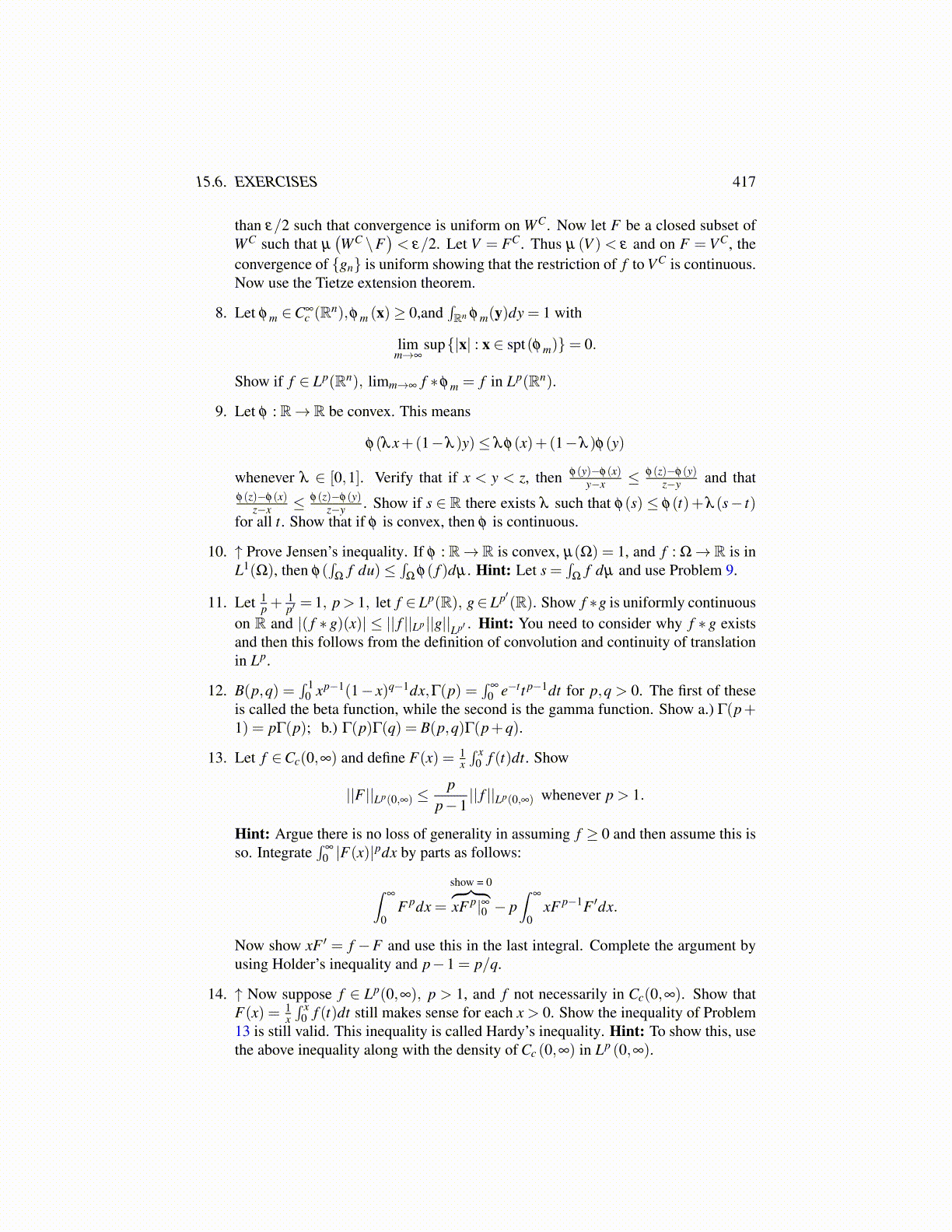
15.6. EXERCISES 417
than ε/2 such that convergence is uniform on WC. Now let F be a closed subset ofWC such that µ
(WC \F
)< ε/2. Let V = FC. Thus µ (V ) < ε and on F = VC, the
convergence of {gn} is uniform showing that the restriction of f to VC is continuous.Now use the Tietze extension theorem.
8. Let φ m ∈C∞c (Rn),φ m (x)≥ 0,and
∫Rn φ m(y)dy = 1 with
limm→∞
sup{|x| : x ∈ spt(φ m)}= 0.
Show if f ∈ Lp(Rn), limm→∞ f ∗φ m = f in Lp(Rn).
9. Let φ : R→ R be convex. This means
φ(λx+(1−λ )y)≤ λφ(x)+(1−λ )φ(y)
whenever λ ∈ [0,1]. Verify that if x < y < z, then φ(y)−φ(x)y−x ≤ φ(z)−φ(y)
z−y and thatφ(z)−φ(x)
z−x ≤ φ(z)−φ(y)z−y . Show if s ∈ R there exists λ such that φ(s) ≤ φ(t)+λ (s− t)
for all t. Show that if φ is convex, then φ is continuous.
10. ↑ Prove Jensen’s inequality. If φ : R→ R is convex, µ(Ω) = 1, and f : Ω→ R is inL1(Ω), then φ(
∫Ω
f du)≤∫
Ωφ( f )dµ . Hint: Let s =
∫Ω
f dµ and use Problem 9.
11. Let 1p +
1p′ = 1, p> 1, let f ∈ Lp(R), g∈ Lp′(R). Show f ∗g is uniformly continuous
on R and |( f ∗ g)(x)| ≤ || f ||Lp ||g||Lp′ . Hint: You need to consider why f ∗ g existsand then this follows from the definition of convolution and continuity of translationin Lp.
12. B(p,q) =∫ 1
0 xp−1(1− x)q−1dx,Γ(p) =∫
∞
0 e−tt p−1dt for p,q > 0. The first of theseis called the beta function, while the second is the gamma function. Show a.) Γ(p+1) = pΓ(p); b.) Γ(p)Γ(q) = B(p,q)Γ(p+q).
13. Let f ∈Cc(0,∞) and define F(x) = 1x∫ x
0 f (t)dt. Show
||F ||Lp(0,∞) ≤p
p−1|| f ||Lp(0,∞) whenever p > 1.
Hint: Argue there is no loss of generality in assuming f ≥ 0 and then assume this isso. Integrate
∫∞
0 |F(x)|pdx by parts as follows:
∫∞
0F pdx =
show = 0︷ ︸︸ ︷xF p|∞0 − p
∫∞
0xF p−1F ′dx.
Now show xF ′ = f −F and use this in the last integral. Complete the argument byusing Holder’s inequality and p−1 = p/q.
14. ↑ Now suppose f ∈ Lp(0,∞), p > 1, and f not necessarily in Cc(0,∞). Show thatF(x) = 1
x∫ x
0 f (t)dt still makes sense for each x > 0. Show the inequality of Problem13 is still valid. This inequality is called Hardy’s inequality. Hint: To show this, usethe above inequality along with the density of Cc (0,∞) in Lp (0,∞).